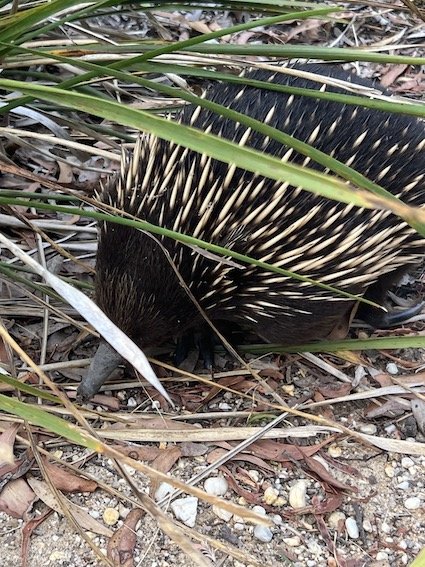On my final walk of the summer holidays, I decided to take a different path towards the beach. A little way along I almost stepped on this guy …a beautiful echidna, snuffling for ants and seemingly oblivious to my presence. It let me stay so close I could see the strange curve of its claws, the colour of its spines and the tiny hairs on its beak. This glorious, strange monotreme, unique to this country. Right in front of me and endlessly fascinating. This was a small but beautiful moment of ‘awe and wonder’. It slowed me down and drew me in. What a generous parting gift from nature as my holiday came to an end. For me, such encounters, never fail to be exhilarating. I can literally feel my heart respond, beating loudly in my chest, my breath quickening and the smile growing on my face. I am alone, deeply connected and fully present.
I am fortunate to be able to spend a lot of time in the natural environment. It is the source of my well-being and the sustenance of my curiosity. As has been noted by many, being in nature also helps keep our ego in check. It literally puts us in our place. We are reminded that we are indeed, a tiny speck in what is a much bigger universe. We don’t matter as much as we think we think we do. The natural environment is also the place I can rely on to nurture my curiosity – a disposition so vital to inquiry.
My echidna encounter was, of course, a simple, natural provocation. As I kept walking, I was aware of the questions ‘bubbling up’ in my mind. ‘Why didn’t it walk away? Does it have a burrow/nest somewhere? Why do I only ever see them on their own? Are they solitary? What are its predators here? I have written elsewhere about what I feel to be at times, and a necessary emphasis on artificially constructed provocations for children. Or the sense that at times children are required to ask questions about things that they actually have no genuine curiosity about.
As we move into a new year, and after several weeks of being immersed in the natural environment, I am convinced yet again, that the best way to provoke, curiosity or and wonder in our learners is to remain open to the natural provocations that are around us each day. Whilst there are copious resources and advice about cultivating curiosity these days (my own work included!), perhaps the best advice is the most simple. Get outside and, as the wonderful astrophysicist Neil de Grasse Dyson implores, get out of their way. Use the natural world, the surrounding community, the school grounds, a walk around the block. The world will provide. And be curious. Share your moments of curiosity and wonder with your learners. Susan Engel and others who have done the deep research work in this field conclude that the role of the adult in nurturing children’s curiosity is critical. I know that my little Echidna story and video will find its way into my teaching in the coming weeks. I will show children the photos and clips I took and share how I felt, what I noticed, and the questions that I walked away with. It will be real and it will be from the heart. I may show them how I did some further investigation or they may start sharing their own moments of wonder from their holidays. Or both! Either way, I plan to intentionally and authentically be the curious learner I want to see in them. (And, no, they won’t need to be studying ‘animals’ to warrant that moment.)
Cultivating curiosity in children begins with cultivating it in ourselves. It means giving ourselves permission to take an unexpected pathway, slow down, notice and wonder. My time away was filled with small moments of wonder and awe gifted to me by nature. The politics of the birds in my garden (why are some species so much more aggressive than others?), the changing landscape of the beach I have walked since childhood (where have all the shells gone?), the sudden arrival of hundreds of dragonflies (why now?), the fog hanging so low over the ocean on a warm morning (why fog? is this basically a low cloud? What causes this?). These musings not only help me continue to walk the world with a curious mind but provide me with something simple, real and rich to share with learners.
… and when I do, I want them to reciprocate. I want to create a culture in which THEY excitedly bring their small moments of wonder into the classroom like precious jewels cupped in their hands. Not only do we stimulate creativity and imagination through such sharing , we light the spark for true dialogue and discovery. Each moment of genuine wonder has the potential to connect with powerful and transferable concepts. My Echidna encounter connects to concepts such as diversity, adaptation, environment and behaviour: ‘from little things,’ as singer Paul Kelly writes, ‘big things grow’
In almost all cases, the authentic moments of wonder experienced by learners be easily traced back to the curriculum. Knowing your curriculum deeply helps you let it go and give yourself permission to lean in close to your learners and say, “I’m listening, that sounds WONDERful, tell us more …
How will you nurture your own and your learners’ curiosity as you begin the year?
How will you stay awake to the simple provocations the world will bring to you?
Just wondering…
Kath

